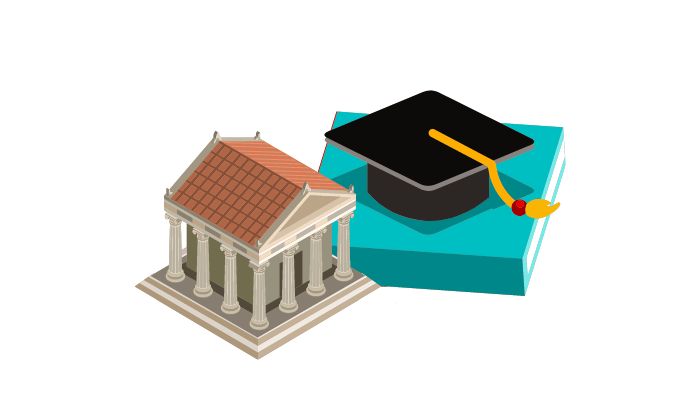How students’ expectations from universities are changing
Students are demanding services from their universities that will improve their chances of success rather than neatly manicured lawns
August 25, 2022

Two years ago, my kid was in the college/ university admissions application phase. I asked her what factors were most important to her when deciding whether to put a college on her shortlist. Her answer: a) academic excellence and reputation, and b) whether the university seems to care for the welfare of its students. The former was not surprising but seeing the latter so high up on her priority list surprised me.
Students’ expectations from colleges and universities are changing. Once upon a time, students used to grudgingly accept whatever they were offered. When I was an undergrad myself at a sought-after public engineering university, there was no common room, not even a separate bathroom, for women. Social activities for students were non-existent, save for student wings of political parties (if you want to count those). We had no expectations for anything better.
All we thought about was getting through the four years with no concept of what a university experience ought to be. Some faculty members made no bones telling me and other female students to our faces that we were not welcome on campus - “Respectable girls have no business in an engineering university”. As if that was still ambiguous, some faculty members would occasionally publicly humiliate female students for not covering their heads or for just sitting on the pavement outside the departments like college students do.
Attending even a reputable college or university meant you put your head down, attended classes, and demanded nothing else – no academic counseling, no welfare, no career guidance, no internship support, and no networking with alumni. A male family member who went to one of our country’s best universities in the ‘90s succinctly described his batch’s experience saying, “We did not go to university to learn, we tackled it so we could graduate.”
The relationship between universities (especially management) and their students is often an adversarial one. As a result, while alumni retain lifetime relationships with their peers long after they graduate, most heave a sigh of relief knowing they can finally turn their back on their alma mater and will never have to deal with it again. This is mirrored by the indifference most institutions show towards their graduates by a complete lack of tracking and continued engagement. The graduation ceremony is akin to a divorce shower that celebrates the end of a bad relationship.
Social integration on campuses is a prerequisite for learning. If students do not feel like they belong or, even worse, feel like they are treated as a nuisance, learning and preparedness for the future will suffer. Public and private schools have been expanding access to education across the country, albeit at an anemic pace. That means that our colleges and universities are now sourcing students from more diverse backgrounds and locations than ever before, making Pakistan’s Gen Z the most diverse it has ever been. For students who are less travelled and come from mostly segregated (based on sex) school experiences, university is the first time in their lives they have to live and forge friendships with people of ethnicities, sex, and cultural norms different than their own.
Experiences like these are no longer good enough or acceptable. Fortunately, over the years, at least a few universities have caught up to the times and have begun addressing some of these severe shortcomings by adding functional student support services. IBA, LUMS, GIKI and NUST are some universities I am aware of that have active alumni associations with global reach which aid members to stay connected and engaged for more than a decade. They enable alumni to pay it forward by funneling donations to fund scholarships and other opportunities for students at their alma mater. But that requires students to have a positive student experience and a big piece of that is the expectation of having student support services available.
Unfortunately, the institutions I named as examples above are exceptions, not the rule. Many colleges and universities continue to take ham-handed actions that destroy, rather than foster, goodwill for the institution among students – confiscating cell phones from women students, ethnic profiling, and imposing arbitrary dress codes.
In 2018, The Chronicle of Higher Education issued a report titled ‘The New Generation of Students - How colleges can recruit, teach, and serve Gen Z.’ It is filled with insights for university leaders and identifies key aspects in which demands and expectations Gen Z, the generation born between 1995 and 2012, has from them and how they differ from preceding generations, such as: Millennials (1980-95), Gen X (1965-80), Baby boomers (1946-65), the Silent generation (1928-46) and all the way back to the Greatest Generation (1918-28). Obviously, the entire report is prepared in the American higher-ed context, which means several conclusions and trends have no equivalence for us.
The Chronicle’s report makes a key observation which, supported by nothing more than anecdotal evidence, I believe is probably true in Pakistan as well; Unlike their predecessors, the Millennials, that had a consumer mentality and demanded on-campus amenities like suite style residences and all manner of recreational facilities, for Gen Z “services are the new amenities” (career development, tutoring, advising, and mental health support).
Furthermore, having lived through the Dot-com bubble and the Long Recession, this generation prioritizes the value of and rate-of-return on (what is now a very expensive) college education over luxuries and having a good time. Gen Z views university education not as a general preparation for life but as career preparation.
Reading The Chronicle’s report makes you realize that the boundaries that demarcate these generations are marked by experiences, milestones and events that are not shared by populations outside the Western world. Pakistan’s living generations are more likely to have been shaped by events and traumas in their own history, like the partition of 1947, Ayub’s martial law, the partition of 1971, Zulfikar Ali Bhutto’s assassination, Zia’s dictatorship, the Soviet invasion of Afghanistan and jihadi culture, the political game of musical chairs of the 90s, US sanctions on Pakistan under the Pressler amendment, Pakistan and India’s tit-for-tat nuclear tests in 1998, 9/11, Musharraf’s dictatorship, the long war-on-terror that followed, Benazir Bhutto’s assassination, the TTP’s terror campaign, etc. These events have probably shaped and bracketed Pakistan’s generations and do not align with Western definitions.
That begs the question, do higher education institutions even know who their students today are and what they want from them? Do colleges and university leaders know their own communities?
An ongoing effort to gather answers to these and other questions has shown that students in Pakistan want to graduate with employable skills, hands on experience, and student support services (like mentoring, advising). They want usable and accessible community spaces on campus, athletic facilities, libraries, and cafeterias. Private university goers do not seem to think they are getting value for the money they are paying. For example, a student at a private university studying computer science said they had to take private coding lessons because the university computer lab is inadequate.
It is in the best interest of colleges and universities to know these things. Unfortunately, they seem to lack the means and ability for such a systematic study. The same goes for the HEC which is already stretched thin performing many functions it should extricate itself from.
A practical approach to understanding the landscape of student expectations is for the HEC to commission such a study with one of several think-tanks or institutes that have the necessary technical expertise, of which there are a few. Doing it right would cost a pretty penny which the HEC is unable to spare in a year of shrinking budgets (in real terms). Fortunately, if a competent partner can be identified to conduct this landscaping study, this is the kind of support I am certain donors will be all too happy to provide.
Students are demanding services from their universities that will improve their chances of success rather than neatly manicured lawns and vanity projects. I take that as a sign of a gradually maturing student population that is concerned about its own future and understands that after graduation good opportunities are neither the norm nor to be taken for granted. These are not the students of the 80s or 90s or even the 2000s. Universities and policymakers need to revise their understanding of who their students are and understand their most pressing needs.
The writer (she/her) has a PhD in Education.
Originally published in The News











